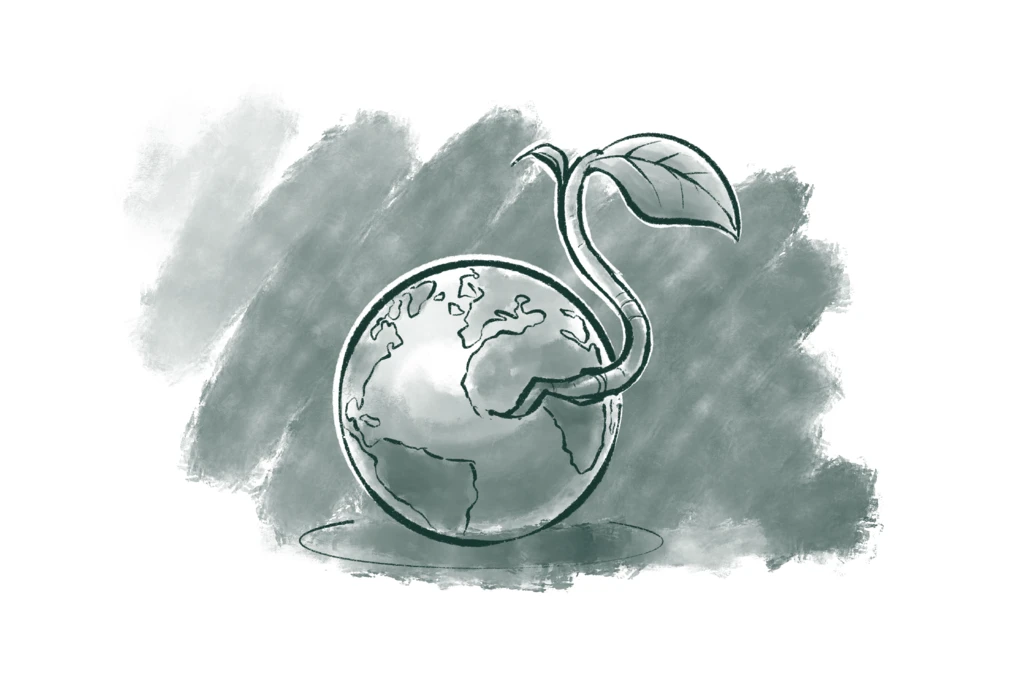The global population is projected to soar to about 10 billion people by 20501, posing a significant challenge: how do we farm enough food to feed everyone?
The global population is projected to soar to about 10 billion people by 20501, posing a significant challenge: how do we farm enough food to feed everyone?

This challenge is compounded by the impacts of climate change on agriculture, requiring solutions that not only boost food production but also protect the environment and lessen the burden on our planet.
Is there a solution that can help solve this complexity? Surprisingly, yes – it lies in the bacteria and fungi living in the soil. These tiny organisms are already making agricultural practices more environmentally friendly and helping farmers increase their crop yields.

Before we explore how using bacteria and fungi can transform agriculture and help us feed 10 billion people, let's first understand the current challenges in farming.
Feeding a growing population isn't a new challenge for global policymakers. In the 1960s, a similar crisis was addressed successfully, but it came with serious collateral damage.
Back in 1960, the world’s population hit three billion, causing widespread panic. Why? Because it took 123 years, from 1804 to 1927, for the world to grow from one billion to two billion people. But it only took 33 years to jump from two billion to three billion2!
However, thanks to the dedicated efforts of individuals, organizations, and government agencies, a series of measures were implemented globally, leading to a tremendous boost in agricultural productivity – a movement known as the “Green Revolution.” Key components of this revolution included the widespread use of chemical fertilizers and pesticides, improved irrigation facilities, and high-yield seed varieties.
According to the Food and Agriculture Organization3, between 1970 and 1990 fertilizer use surged by 360 percent, and pesticide use increased by 7-8 percent per year in developing countries. Global cereal yields rose from 1.4 tonnes per hectare in the early 1960s to 2.7 tonnes per hectare in 1989-91. In Asia, the most populous continent, cereal yields jumped from just above 1,000 kilograms per hectare to over 2,500 kilograms per hectare.
However, this heavy reliance on fertilizers and pesticides led to the pollution of waterways, the poisoning of agricultural workers, and a decline in soil quality as well as biodiversity4.
Moreover, the production and use of fertilizers and pesticides contribute significantly to climate change. For example, nitrogen fertilizers account for nearly 5 percent of global greenhouse gas emissions5. Their use in agriculture releases nitrous oxide, a gas 300 times more potent than carbon dioxide in warming the planet6.
Despite their drawbacks, fertilizers and pesticides remain crucial for growing more food. Their usage has increased dramatically and it is estimated that anywhere between 30 percent to 60 percent of the food we eat is grown with the help of fertilisers7.
Therefore, to feed 10 billion people by 2050, we cannot simply increase pesticide and fertilizer use in agriculture. We need solutions that can replace or reduce our dependence on these chemicals while still boosting agricultural productivity.

Climate change is already disrupting agriculture, making it harder for farmers to sustain their livelihoods. According to a recent study published in the journal Nature Climate Change8, global agricultural productivity is 21 percent lower than it would be without the impacts of climate change. The losses are even more pronounced in warmer regions, with agricultural productivity declining by 34 percent in Africa and 26 percent in Latin America due to climate change.
Climate change affects agriculture in several ways:
Rising temperatures: Higher temperatures cause heat stress on crops, reducing their growth and yield. Each degree Celsius increase in global temperature could lower yields of major staple crops by 6 percent for wheat, 3.2 percent for rice, 7.4 percent for corn, and 3.1 percent for soybeans9.
Declining soil quality: Climate change impacts the soil quality as well and this can vary from region to region, including degradation due to soil erosion, desertification due to loss of moisture10, reduced ability of soil to absorb water11, and even impact microbes living in the soil essential for plant growth12.
Frequent droughts: Droughts are becoming more common and severe due to climate change, leading to water scarcity for irrigation. According to the World Bank, drought conditions are expected to increase by up to 60 percent in some parts of the world by 2100, significantly affecting crop productivity13.
Increase in pest attacks: Warmer temperatures and changing precipitation patterns create favorable conditions for pests and diseases to thrive. Research published in Nature Climate Change estimates that crop losses due to insect pests will increase by 10-25 percent per degree Celsius of warming, with the greatest impacts in temperate regions14.

Erratic and extreme rainfalls: Unpredictable and extreme weather patterns, such as sudden heavy rains or prolonged dry spells, disrupt farming schedules and damage crops. Climate change is considered a culprit for the rise in the frequency and intensity of heavy rains causing flash floods across many regions, especially in North America, Europe, and Asia, and with the rising temperatures, the situation is expected to worsen15.
Understanding these challenges sets the stage for exploring innovative solutions like BioAg.
This article is part of The biosolutions bulletin. Want it in your inbox every month?

Now that we’ve outlined the challenges in achieving higher agricultural productivity, let's explore how soil bacteria and fungi can help. But first, let's talk about the importance of a balanced diet!
We all know how crucial a balanced diet is – meals rich in proteins, carbohydrates, fats, vitamins, minerals, and fiber. While supplements are available, we prefer getting our nutrients from natural foods to stay strong and healthy. The same principle applies to plants.
Plants first appeared on Earth around 500 million years ago16 and have since evolved into about 400,000 species, thriving in diverse environments – from the arctic tundra to scorching deserts and salty seas. How did they manage this? With a balanced diet of sunlight, water, and soil rich in minerals and microbes like bacteria and fungi. They didn’t need fertilizers or pesticides!
However, in agriculture, things are different. We want every plant to grow perfectly and produce abundant food – wheat, rice, corn, peanuts, and more. We don’t apply the “survival of the fittest” rule to our crops; we want every plant to be fit. Thus, human intervention with manure, irrigation, fertilizers, and pesticides became necessary.
Given the negative impacts of fertilizers and pesticides and the need for resilient crops in the face of climate change, scientists sought ways to strengthen plants from within, to provide them with a "balanced meal". The answer lay in soil bacteria and fungi.
So, instead of adding chemicals to the soil, scientists thought: what if we added beneficial bacteria and fungi to let nature strengthen the plants naturally? This would help plants produce more food and become more resilient to pests, mirroring the effects of fertilizers and pesticides but without the harmful chemicals. Plus, producing bacteria and fungi doesn’t require energy-intensive factories.
This idea gave birth to biological solutions for agriculture, or BioAg. These solutions, inspired by nature, harness the power of natural processes to help plants grow better and support our goal of feeding a growing population.
Fertilizers provide essential nutrients to plants, primarily nitrogen, phosphorus, and potassium. Soil contains various bacteria that help plants absorb these nutrients, but soil quality and microbial availability can vary greatly from one region to another. Additionally, large fields with many plants competing for nutrients and the impacts of climate change can weaken plants and degrade soil quality. However, adding beneficial microbes to the soil in the right quantities can be a game-changer. Products that use microbes to promote plant growth are known as biostimulants.

One such biostimulant that helps farmers improve the quality of their crops combines three microbes: a bacterium called Bacillus amyloliquefaciens and two fungi, Penicillium bilaiae and Trichoderma virens17. These three microbes work together to enhance plants' ability to absorb nutrients from the soil, resulting in healthier plants and higher crop yields. Studies found that the biostimulant can increase wheat yields by as much as 3.8 bushels per acre18.

Another popular biosimulant used in farming contains a naturally occurring soil fungus called Penicillium bilaiae. This fungus promotes root development in plants by making more phosphate available in the soil. Research has shown that its usage on pea plants increased the amount of root hair by 22 percent and the length of root hairs by 33 percent19. But how do longer and larger roots help plants? Well, they make it easier for plants to find water during droughts and hold onto nutrients when it rains a lot20.
Moreover, using this roots-enhancing biostimulant can both increase the efficiency and reduce the need for phosphate fertilizers in farming, which is great for the environment. Studies show that it can lower carbon dioxide emissions by 15 percent in corn production. If every cornfield in the US used the biostimulant, it would cut carbon emissions by four million metric tonnes21. That's like taking 952,007 petrol-run cars off the road for an entire year! (Using https://www.epa.gov/energy/greenhouse-gas-equivalencies-calculator).
Also, up to 90 percent of phosphate from chemical fertilizers is unused by plants. A large portion of this unused fertilizer ends up in freshwater bodies, causing water pollution. By making more phosphate available to plants, biostimulants help reduce the inefficiencies of chemical fertilizers, thus reducing the fertilizer runoff into water bodies.
Did you know that just one gram of soil can contain up to 10 billion microbes22, including a billion bacteria? Apart from bacteria you can also find in soil fungi, tiny worms called nematodes, and even viruses. While some of these microbes are essential for plant survival, others can cause diseases in them or even prove fatal. Fortunately, some "good microbes" have the power to eliminate the "bad microbes."
Good microbes protect plants against bad microbes through three main modes of action:
Biotechnology has advanced to a point where scientists can identify beneficial microbes that naturally eliminate harmful ones in the soil. These helpful microbes can be supplied to farmers as an eco-friendly way to protect their crops from potential damage caused by harmful microbes. This reduces the farmers' reliance on chemical pesticides, promoting healthier farming practices. These beneficial microbes, when used for crop protection, are known as biocontrol products.

For instance, one commonly used biocontrol product contains the bacterium Bacillus subtilis var. amyloliquefaciens, which can shield plants from over a dozen diseases by creating a protective barrier around the plants. Another example is Streptomyces lydicus, a bacterium that thrives both on the plant's surface and its roots, offering continuous protection from harmful microbes in the air and soil. These biocontrol products not only help prevent crop loss but also support sustainable agriculture by reducing the need for chemical pesticides.
As we've seen, BioAg solutions offer a promising path forward, but what does this mean for the future of agriculture and food security?

The need for sustainable, efficient agricultural practices is more critical than ever. BioAg – the use of beneficial bacteria and fungi in agriculture – represents a transformative approach. By leveraging these natural allies, we can boost plant growth, improve nutrient absorption, and enhance resilience against climate change and pests.
The beauty of BioAg lies in its simplicity and alignment with nature. Instead of battling against nature with synthetic chemicals, BioAg is working with it, harnessing the power of tiny microbes to achieve big results. BioAg not only nurtures plants from the inside out but also supports healthier ecosystems, and is in harmony with how ecosystems evolved over millions of years.
As we look forward, embracing BioAg could transform our food security narrative from a daunting challenge to a manageable journey. The journey to feeding 10 billion people may be daunting, but with BioAg as our ally, we have a natural tool to pave the way.

1. Non-human farmers:
It's not just humans who perform farming or use biocontrol measures. A species of ants called the Leafcutter Ants, found primarily in Central and South America, cut leaves and bring them back to their colonies, not to eat, but to create their fungal gardens, which serve as their main food source. They meticulously care for their fungus and even use some "good bacteria" as biocontrol measures to fight against pests.
2. Self-defense for microbes, antibiotics for humans:
Long before humans discovered antibiotics, soil microbes were already producing them. One of them is the bacteria species Streptomyces, which produces the majority of antibiotics used by humans today. These microbes have been synthesizing antibiotics for millions of years to compete against other soil microbes and eliminate harmful competitors.
3. Urban farming pioneers:
Did you know that during World War II, "Victory Gardens" played a crucial role in ensuring food security in many countries? These were small home and community gardens that sprung up across the nation, where citizens would grow their own food. Families gathered to plant, tend, and harvest the produce. In the US, Victory Gardens were the source of almost 40 percent of the entire vegetable supply.
4. Green revolution hero:
Norman Borlaug is often hailed as the "Father of the Green Revolution" for developing high-yield, disease-resistant wheat varieties. His innovative research is credited with saving over a billion people from starvation, particularly in countries facing food crises. Borlaug was awarded the Nobel Peace Prize in 1970.

Sources:
1. World population projected to reach 9.8 billion in 2050, and 11.2 billion in 2100, UN
2. The World at Six Billion, UN
3. Towards a New Green Revolution, FAO
4. Green Revolution: Curse or Blessing?, IFPRI
5. Greenhouse gas emissions from nitrogen fertilizers could be reduced by up to one-fifth of current levels by 2050 with combined interventions, Nature Food, 2023
6. Fertilizer and Climate Change, MIT Climate Portal, 2021
7. How many people does synthetic fertilizer feed?, Our World In Data
8. Anthropogenic climate change has slowed global agricultural productivity growth, Nature Climate Change, 2021
9. Temperature increase reduces global yields of major crops in four independent estimates, Science, 2017
10. Soil, land and climate change
11. Soils Could Be Affected by Climate Change, Impacting Water and Food
12. Soil Microbiomes and Climate Change
13. Groundswell: Preparing for Internal Climate Migration
14. Increase in crop losses to insect pests in a warming climate, Nature Climate Change, 2018
15. IPCC Sixth Assessment Report, Chapter 11: Weather and Climate Extreme Events in a Changing Climate
16. Land plants arose earlier than thought—and may have had a bigger impact on the evolution of animals
17. BioniQ wettable powder nutrient-solubilizing inoculant for corn, sorghum, canola, all wheat, oats, mustard, barley and rye, Novozymes
18. Proven efficacy of BioniQ®, Novozymes
19. Novozymes BioAg US Product Guide 2022
20. Improving food security in the face of climate change with biosolutions
21. JumpStart®: Lower emissions and healthier aquatic environments
22. Number of cells in one gram of soil
23. Taegro 2: Biofungicide
24. Novozymes Actinovate®
Imagine you’re visiting a carrot farm. Your friend, the farmer, hands you a freshly pulled carrot to munch on. Would you eat it without washing it? Probably not! You would first wash it, worried about germs from the soil clinging to it.
And those concerns are valid. Studies show that just one gram of soil from the rhizosphere—the space around plant roots—can contain up to one billion bacteria. This region is bustling with countless other microbes too, including tiny worms called nematodes, fungi, algae, viruses, and parasites.
Microbes and enzymes are tiny but mighty agents of change. For billions of years, they’ve enabled transformation in all living things through microbiology.

Get the answers to these questions and more from the monthly biosolutions bulletin. Whether you’re an expert who wants to keep on top of the latest innovations or just starting to learn about biosolutions, we’ve got you covered.
With stories ranging from the role of biosolutions in food security to how they enable NOMA-style dining experiences, there’s something for everyone.
Don’t miss out on the latest news about how biosolutions better our world. Sign up to get the biosolutions bulletin delivered directly to your inbox.
To complete the get in touch form or sign up, please click on the button below to enable cookies.